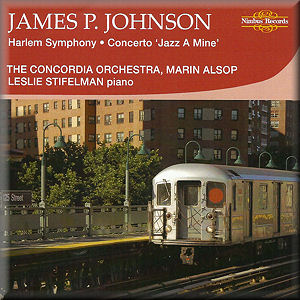1. Victory Stride
Harlem Symphony
2. Subway Journey
3. April in Harlem
4. Night Club
5. Baptist Mission
Concerto Jazz A Mine
6. Movement I: Allegro
7. Movement II: Adagio
American Symphonic Suite
8. Lament
9. Drums - A Symphonic Poem
10. Charleston
The Concordia Orchestra conducted by Marin Alsop
with Leslie Stifelman - Piano
Frederick Boothe - Tap dancer
As I said in my review of the album Jazz Nocturne, George Gershwin wasn't the only composer trying to fuse jazz with "serious" music in the twenties and thirties. One of the other explorers was the pianist James P. Johnson, whose Yamekraw was on that Jazz Nocturne CD. Surprisingly, it is not on this album, whose title might lead you to think that these are all the symphonic works that Johnson wrote.
In fact he composed two symphonies, two one-act operas, two ballets, concertos for piano and clarinet, and various pieces of chamber music. Johnson is best remembered today as "the father of stride piano" - a jazz form which influenced such pianists as Fats Waller and Art Tatum. Yet his ambition was to be a "serious" composer using African-American themes, and this album contains examples of his work in that genre.
Inexplicably, the works are not arranged chronologically, which might have helped listeners trace any development in James P's abilities. The opening Victory Stride dates from 1944 and is a triumphal piece anticipating the victory over the Nazis a year later. Its mood is very like the earliest piece on the album - Charleston from 1923 - and there is space for short solos from Leslie Stifelman (piano), Lawrence Feldman (clarinet), James Pugh (trombone) and Chris Gelder (trumpet). The Concordia Orchestra manages to capture the jazz feeling, as it does in most of the pieces on the album, although there are moments of stiffness.
Harlem Symphony is a four-part suite from 1932, painting sound pictures of various aspects of Harlem. Subway Journey depicts Harlem's various neighbourhoods: home to the Jewish, Spanish and African-American communities. April in Harlem is wistful and melodic, reminiscent of Gershwin. Night Club is appropriately jaunty, with a ragtime feel. Baptist Mission opens with a mournful melody which is used as the theme for a set of variations. Rudi Blesh described it as a "syncopated passacaglia on the hymn I Want Jesus to Walk with Me".
Concerto Jazz A Mine (1934) is a piano concerto consisting of the two movements which remain from the original three. The first movement has strong echoes of Rhapsody in Blue, although there is a passage of boogie-woogie before some typical James P stride. The second movement has a lovely placid melody which is buoyantly developed and clearly performed by pianist Leslie Stifelman.
The American Symphonic Suite, also from 1934, was originally in three movements but only the first, Lament, survives. It is actually a set of variations on W. C. Handy's St Louis Blues, which is creatively transformed in a variety of moods. This and the other pieces based on variations remind us that this is a genre shared by jazz and classical music.
Drums - A Symphonic Poem from the early 1940s begins with a powerful timpani solo which recurs several times during the piece - another composition based on the pattern of variations. The album ends with Johnson's best-known composition - the Charleston, written for the 1923 musical Runnin' Wild. It started a dance craze among the "flapper" generation and is still a popular dance tune many years later. This particular arrangement keeps us in suspense for three minutes before the tune actually arrives. The educated feet of tap dancer Frederick Boothe are accompanied by the piano and double bass before a faltering trumpet solo and more secure solos by clarinet and trombone.
This album was originally released on the Music Masters label in 1994 and the recorded sound is very acceptable. Several of these compositions were found thanks to the co-operation of James P's family, and it is good to have these proofs of Johnson's ability as a composer, which is too often overlooked.
Tony Augarde
See also review
by Rob Barnett
